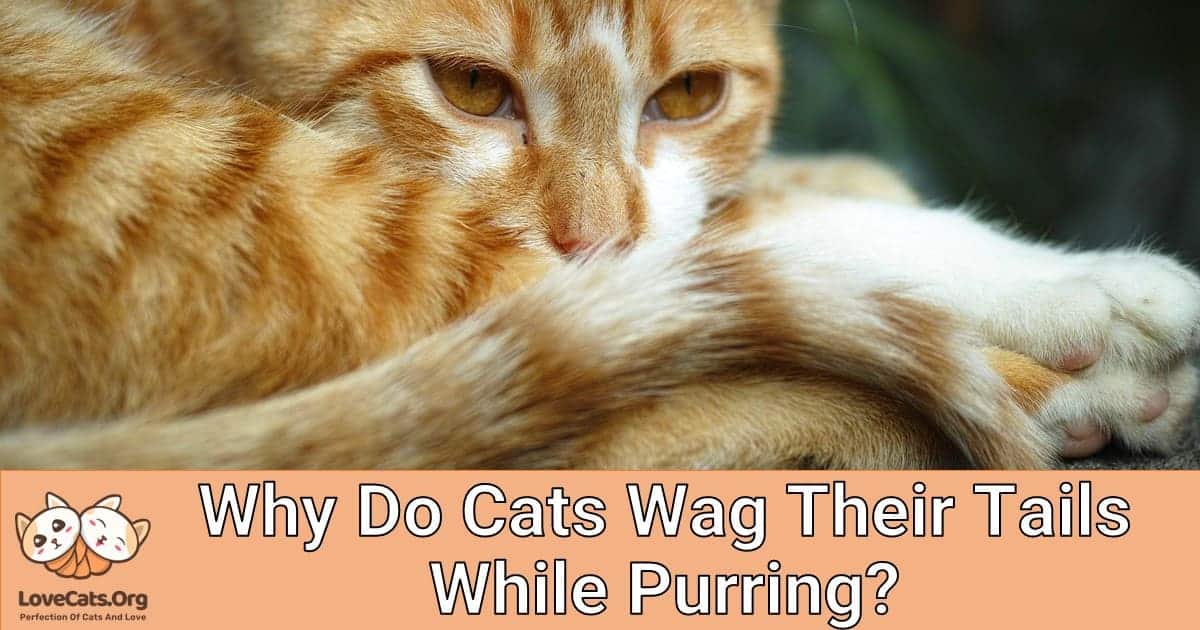Cats have many unique behaviors, one of which is wagging their tails while purring.
This behavior has puzzled cat owners for years, and there’s still no definitive answer as to why cats do this.
It could be a sign that the cat feels content or happy.
Others may be trying to communicate something specific with us humans.
Whatever the reason, watching your kitty happily wag its tail while purring can bring joy into any home!
Here are some possible explanations:
- Cats use their tails like flags when feeling relaxed and comfortable in an environment (like being around you). Then they’ll start waving them back and forth along with their purrs;
- It might also indicate pleasure – if your feline friend enjoys petting or playing games together, she will likely show her appreciation by combining both activities.
- Cats sometimes combine these two actions because it helps release endorphins – hormones associated with happiness and relaxation–which makes sense. since most felines love cuddling up next to someone special after a long day of playtime fun!
All in all, we don’t know exactly why our furry friends engage in such adorable antics.
Still, whatever the case may be—it sure does make life more enjoyable having them around!
Why Is My Cat Wagging Its Tail?
My cat wagging its tail is a sign of happiness and contentment.
It’s an expression that cats use to communicate with us, their owners!
Cats will often wag their tails when they are feeling relaxed or playful.
It can also be used as a way for them to show affection towards people or other animals.
Here are some common reasons why your cat may be wagging its tail:
- They’re excited – If you’ve just come home from work, your kitty might start swishing her tail back and forth in anticipation of being petted by you!
- They feel safe – When cats feel secure around someone (or something), they’ll usually express this through the movement of their tails.
- They want attention – Your furry friend could simply be trying to get your attention so she can receive love and cuddles from you!
- They’re playing – Tail-wagging during playtime is very normal behavior among felines. It helps keep up momentum while chasing toys or running after each other.
No matter what the reason behind it may be, one thing remains true. Suppose my cat has their tail held high while swaying side-to-side.
In that case, they must enjoy whatever activity we’re doing together at that moment in time.
And isn’t that all any owner wants?
What Does It Mean That My Cat Wagging Its Tail?
When your cat is wagging its tail, it usually means they are happy and content.
It can also mean they feel safe in their environment or with the people around them.
Cats will often wag their tails when being petted or playing with toys; this indicates pleasure and enjoyment!
Other signs of a happy kitty include purring, kneading (pawing at you), rubbing against objects/people, rolling over for belly rubs, and meowing softly – all these behaviors indicate happiness.
Additionally, cats may twitch their ears back and forth while looking intently at something.
This could signify joy and curiosity about what’s happening around them!
It’s important to note, however, that if your cat starts rapidly twitching its tail from side to side, it does not necessarily indicate happiness but fear or aggression.
So pay attention to other body languages cues, such as flattened ears and dilated pupils, which would suggest distress rather than delight!
If ever unsure, consult a vet who can help assess potential issues more accurately.
Is It Bad If My Cat Is Wagging Its Tail?
It’s okay if your cat is wagging its tail.
This can be a sign of happiness and contentment!
Cats usually express their emotions through body language; how they move or position themselves tells us how they feel.
A happy cat will often have an upright posture with ears forward and eyes wide open. But sometimes cats also use their tails to communicate too!
Here are some examples:
- Suppose your kitty’s tail is held high in the air while twitching back and forth quickly. That means she’s excited about something (like when you come home from work).
- Her tail moves slowly side-to-side like a pendulum, which could mean she feels relaxed and comfortable around you.
- And finally, if her entire rear end starts swaying gently from left to right. Then chances are good that she wants attention or affection from you!
So don’t worry – seeing your furry friend happily swishing their tail should make for a pleasant sight indeed 🙂
How Do Cats Have Control Of Their Tails?
Cats have excellent control over their tails!
They can use them to communicate, balance, and even groom themselves.
Here are some of the ways cats use their tail:
- Communication – Cats will move or twitch their tails when they’re happy, angry, or scared. This helps other animals understand how a cat is feeling in any given situation;
- Balance – A cat’s tail acts like an extra limb that it uses for balancing while jumping from one place to another;
- Grooming – The fur on a cat’s backside is difficult to reach with paws. Hence, they often use their tail as a brush by rubbing against it repeatedly until all areas are clean and debris-free.
Cats also lick each other’s faces which further aids in grooming activities between felines.
All these functions require precise coordination between muscles located at the base of the spine and those along its length.
That’s allowing your feline friend full control over every movement made with this appendage!
Wrapping up: Why Do Cats Wag Their Tails While Purring?
Cats wag their tails while purring for a variety of reasons.
It could be to show contentment, happiness, or even excitement!
They may also do it as an expression of affection towards humans and other animals they are familiar with.
Cats can use tail-wagging with vocalizations like meowing and purring to communicate different messages depending on the situation.
In addition, cats often express pleasure by rubbing against people’s legs when they’re being petted.
This is another way cats demonstrate how much joy they get from interacting with us!
Ultimately, we should all appreciate our feline friends’ unique ways of expressing themselves through body language.
After all, who doesn’t love seeing a happy cat happily waving its tail?


